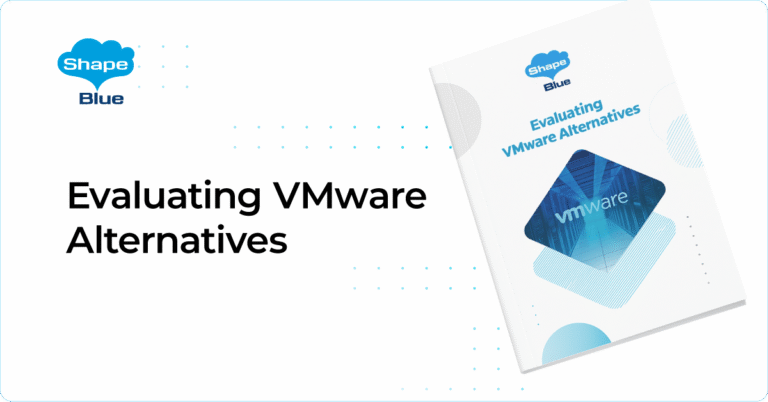As more and more companies build internal private clouds or enter the service provider market with public clouds, the more they will need the right set of tools to launch, manage and scale the Infrastructure as a Service (IaaS) platform more easily. However – choosing the right technology stack can be a difficult decision.
This ShapeBlue IaaS Quick Build Guide provides a straightforward set of instructions to get you up and running with a CloudStack-based Infrastructure-as-a-Service (IaaS) cloud. We have chosen a quick, proven way to easily build an IaaS platform. CloudStack supports a broad range of hypervisors, network, storage and compute technologies, but here we have chosen a simple configuration using KVM on EL8 or Ubuntu, NFS storage and layer-2 isolation using VLANs.
CloudStack is an open-source IaaS cloud orchestrator that powers some of the world’s largest clouds in hands of various ISPs, Telcos and general cloud providers. Its monolithic architecture allows it to be easily implemented, without a need to do hundreds of hours of development in order to provide a bare workable installation. Its simplicity, performance, scalability but also manageability, makes it a default go-to cloud orchestrator in, virtually, all cloud scenarios.
Download the IaaS Quick Build Guide
What’s Inside?
When it comes to cloud management (or cloud orchestration) platforms, the first thing we need to clarify is what we mean by this. A typical cloud management platform allows one to take existing datacentre infrastructure and wrap around it a common API, CLI and user interface, which allows an organization to benefit from the basic concepts of cloud computing in terms of elasticity, metered usage, self-service and resource pooling.
For some, the first choice to make is whether to go for an open-source or a proprietary/vendor solution. This may not come as a surprise to anyone, but at ShapeBlue, we passionately believe the solution should be 100% open-source, and following years of experience, feedback from users and developers, testing most other solutions and working with the community, we also passionately believe the solution should be Apache CloudStack. Apache CloudStack is simple to deploy, has a low cost of ownership, is production proven and highly scalable.
Chapter 2
Apache CloudStack is open-source software designed to deploy and manage large networks of virtual machines, as a highly available, highly scalable Infrastructure as a Service (IaaS) cloud computing platform.
CloudStack is a Cloud Orchestration platform that pools computing resources to build public, private and hybrid Infrastructure as a Service (IaaS) clouds. CloudStack manages the network, storage, and compute nodes that make up a cloud infrastructure.
A CloudStack cloud has a hierarchical structure that enables it to scale to manage tens of thousands of physical servers, all from a single management interface.
Topics covered:
- Architecture Overview
- Zones
- Pods Clusters
- Primary Storage
- Secondary Storage
- Instances
Chapter 3
Infrastructure-as-a-Service (IaaS) can be a complex thing to build, and by definition, it has a plethora of options, which often lead to confusion for even experienced admins who are newcomers to building cloud platforms. The goal of this guide is to provide a straightforward set of instructions to get you up and running with Apache CloudStack v4.18 with a minimum amount of trouble.
This guide can be used to build a small CloudStack test/demo cloud only, as certain networking choices have been made to get you up and running with a minimal amount of time. This guide should not be used for production setup. Its purpose is to help you get a better understanding of Apache CloudStack and learn how to use it and manage a cloud with it, before launching CloudStack for your production environment.
In this guide we will be using Rocky Linux 8.7 (as EL8 variant) and Ubuntu 22.04 LTS (as Ubuntu variant).
KVM, or Kernel-based Virtual Machine is a virtualization technology for the Linux kernel. KVM supports native virtualization atop processors with hardware virtualization extensions.
Topics covered:
- Overview
- Prerequisites
- Environment
- Management Server Installation
- KVM Setup and Installation
- Configuration
Chapter 4
Virtual Private Cloud lets you provision an architecture that resembles a traditional physical network. VPC implements: Tiering isolation, ACL, Site-to-site IPsec VPN, Client VPN and Internal and External Load Balancer.
An example of how you can setup an advanced zone in your local network – in our case, it’s 192.168.1.0/24 network.
Meet the Author
Andrija Panic, Cloud Architect at ShapeBlue
Andrija Panic is a Cloud Architect at ShapeBlue, and is a committer and PMC member of Apache CloudStack. Andrija spends most of his time designing and implementing IaaS solutions based on Apache CloudStack. He has vast experience in building cloud and IaaS solutions for telcos, MSPs and service providers.


